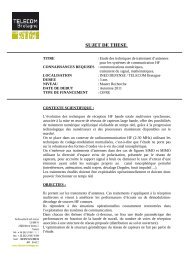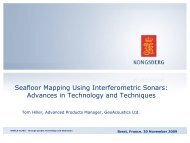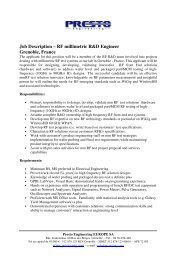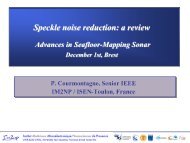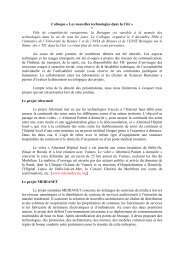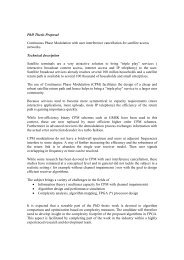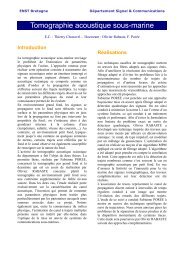Département Réseau, Sécurité et Multimédia Rapport d'Activités 2008
Département Réseau, Sécurité et Multimédia Rapport d'Activités 2008
Département Réseau, Sécurité et Multimédia Rapport d'Activités 2008
You also want an ePaper? Increase the reach of your titles
YUMPU automatically turns print PDFs into web optimized ePapers that Google loves.
estricted to the organization to which the ruleapplies.We claim that many works for the securityinteroperability do not establish a clearseparation b<strong>et</strong>ween (1) the definition of thesecurity policy to be applied in this context, (2)how it is expressed, (3) how it is administeredand (4) how it can be managed. Our O2Oapproach gives a response to each of theseissues.In the O2O approach, interoperability policiesare always defined by the VPO parentorganization and administered by a VPO. Inthis way, the VPO controls all the externalaccesses to the resources of the parentorganization that is involved in aninteroperation. Other issues are discussed inthe published papers [1, 2]. In particular, themanagement of interoperability securitypolicies is based on the concept of sphere ofauthority: each organization defines andmanages its interoperability policies that arewithin its sphere of authority. At each moment,a VPO is within the sphere of authority of theorganization which provides the access to itsresources. An organization A is in the sphere ofauthority of another organization B if thesecurity policy that applies to A is defined andadministrated by B. Furthermore, O2O isflexible because it offers centralized,decentralized and hybrid management.To share understandable knowledge requiredto derive the permitted accesses and usages ofthe information during the interoperabilitysessions, we suggest context ontology to becombined with the OrBAC model and showhow it can be used to ease the security rulesdefinition and derivation during aninteroperability session [3].For this purpose, mapping b<strong>et</strong>ween contextontologies has been defined [4]. This mappingis based on d<strong>et</strong>ection of compatibility relationsb<strong>et</strong>ween ontologies and context revisionoperators. Context revision operators are usedto adapt the mapping b<strong>et</strong>ween security rulesso that each organization involved in theinteroperation can always enforce its securitypolicy. This approach provides a framework todefine interoperability security policies assuggested in the O2O model. Collaborativeactivities in a P2P environment are used as anexample to illustrate our approach.ConclusionThis is only a short overview of the mainprinciples of the O2O approach. We arecurrently implementing our context ontologyand mapping relations in MotOrBAC [5] suchthat the interoperability is acces control modelindependent. So, two organizations caninteroperate although they do not apply bothan organisation access control. Other issuesare discussed in the referenced papers below.In particular, the collaboration of severalorganizations in a VPO may lead to creation ofnew objects. Clearly, these new objects do notbelong to any of the members of the VPO.Managing accesses to new resources createdin a VPO is an issue we are currentlyinvestigating.References[1] F. Cuppens, N. Cuppens-Boulahia and C.Coma. O2O: Managing Security PolicyInteroperability with Virtual PrivateOrganizations. In 13th Annual Workshop of HPOpen-View University Association (HP-OVUA),May 2006.[2] F. Cuppens, N. Cuppens-Boulahia and C.Coma. O2O: Virtual Private Organizations toManage Security Policy Interoperability. InSecond International Conference onInformation Systems Security (ICISS'06),December 2006.[3] C. Coma, N. Cuppens-Boulahia and F.Cuppens. A context ontology based approachfor secure interoperability. In 14th AnnualWorkshop of HP Software UniversityAssociation (HP-SUA) 2007, July 2007.[4] C. Coma, N. Cuppens-Boulahia and F.Cuppens. Context Ontology for SecureInteroperability. Third International Conferenceon Availability, Reliability and Security (AReS2007). Barcelona, Spain. March 2007.[5] F. Cuppens, N. Cuppens-Boulahia <strong>et</strong> C.Coma. MotOrBAC : un outil d’administration <strong>et</strong>de simulation de politiques de sécurité.SARSSI. Seignosse, France, Juin 2006.54 Pracom’s Annual Report <strong>2008</strong>




